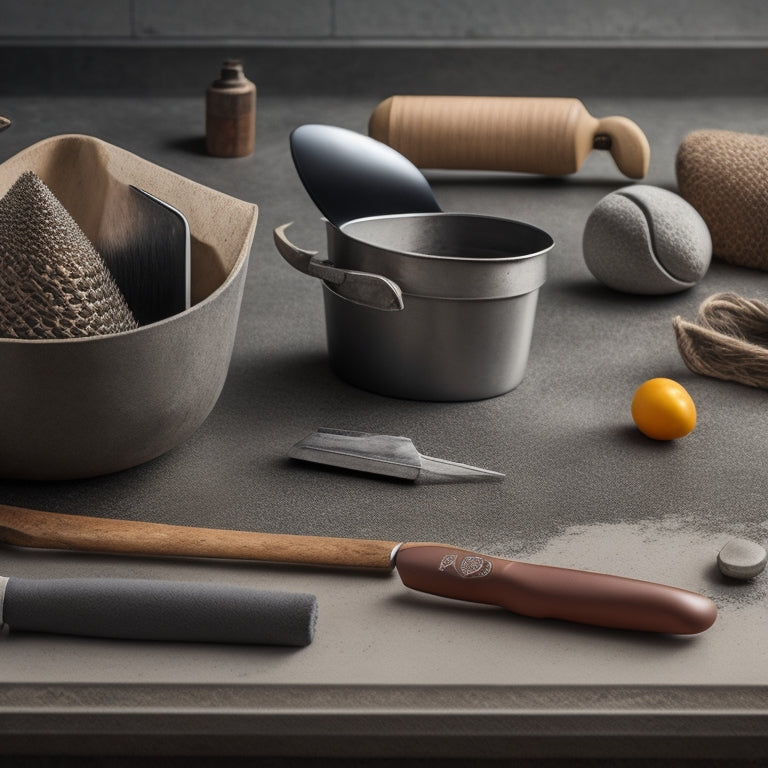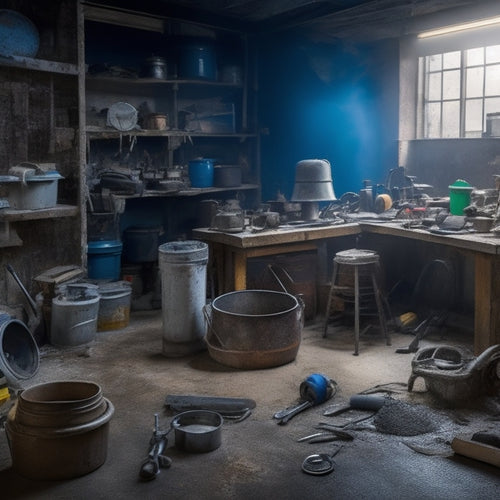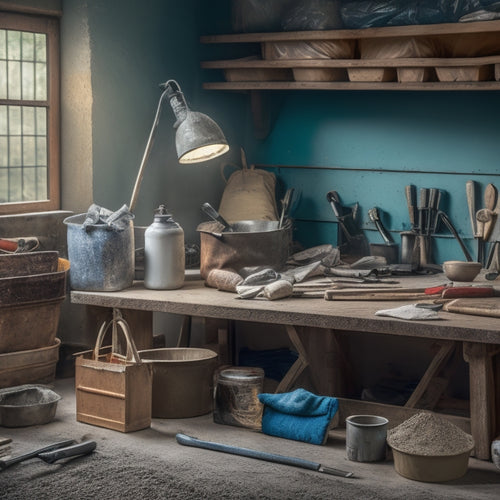
10 Finishing Tools for Perfect Concrete Finishes
Share
You have at your disposal a range of specialized finishing tools that can make all the difference in achieving a flawless concrete finish that meets project specifications and exceeds client expectations. From trowels and float blades that guarantee a smooth surface, to edgers that provide clean lines and brooms that create texture and pattern, each tool plays an essential role. Power trowels and ride-on trowels boost efficiency on large areas, while hand trowels and concrete finishing buggies tackle tight spaces and heavy loads. Vibration screeds achieve perfect flatness, and curing compound applicators guarantee uniform coverage. Discover the nuances of each tool to reveal the secrets of a perfect concrete finish.
Key Takeaways
• Select the right trowel for the job, considering blade material, flexibility, and thickness to achieve the desired finish.
• Master float blade techniques, including angle and pressure, to achieve high-gloss, medium-sheen, or matte finishes.
• Use edger tools to create clean lines and control joint placement, essential for professional-looking concrete projects.
• Choose the correct broom type and technique to create desired textures and patterns, ensuring a uniform finish.
• Consider power trowels, ride-on trowels, and other specialized tools to enhance efficiency, consistency, and safety on large concrete projects.
Trowel Selection for Concrete
When selecting a trowel for concrete, you need to contemplate the type of finish you're aiming for, as different trowel designs and materials are better suited for specific textures and surfaces.
For instance, a steel trowel is ideal for creating a rough, textured finish, while a resin trowel is better suited for achieving a smooth, even surface.
Mastering manual trowel techniques is vital for achieving the desired finish. Start by holding the trowel at a 45-degree angle and applying gentle pressure. As you gain experience, you can adjust the angle and pressure to achieve the desired texture.
Regular trowel maintenance is also important to guarantee the best performance and extend the tool's lifespan. Always clean your trowel after use and store it in a dry place to prevent rust or corrosion.
Additionally, inspect the trowel's handle and blade for signs of wear and tear, and replace them as needed. By following these trowel maintenance tips, you can guarantee a safe and efficient working experience.
Float Blades for Smooth Finishes
When you're working towards a smooth finish, you'll want to pay close attention to the float blade's angle, as it can greatly impact the final result.
You'll also need to choose the right type of float blade for your specific project, considering factors like the concrete's consistency and the desired finish.
Blade Angle Matters
Blade Angle Matters
By adjusting the blade angle of your float blade, you can achieve a remarkably smooth finish on your freshly poured concrete surface. The angle impact of your blade adjustments can make all the difference in achieving a high-quality finish. When you set the blade at the correct angle, you'll be able to effectively remove excess water and evenly distribute the concrete's surface tension.
Here's a breakdown of the ideal blade angles for different concrete finishes:
| Finish Type | Ideal Blade Angle |
|---|---|
| High-Gloss | 10-15° |
| Medium-Sheen | 15-20° |
| Matte | 20-25° |
As you can see, the blade angle directly affects the finish quality. By adjusting the angle, you can achieve the desired level of sheen and smoothness. Remember to always maintain a consistent angle to avoid creating unevenness or marks on the surface. With the right blade angle and technique, you'll be able to achieve a flawless finish that meets your project's requirements.
Float Blade Types
You'll need to choose the right float blade type to achieve a smooth finish, as different blades are designed to handle specific concrete mixes and surface requirements. For instance, resin blades are ideal for high-flow concrete mixes, while polyurethane blades are better suited for low-flow mixes.
Additionally, you may opt for blades with specialized coatings, such as silicone or ceramic, to reduce drag and enhance finish quality.
When selecting a float blade, consider the material's durability and resistance to wear. High-carbon steel blades, for example, are more resistant to corrosion and can withstand heavy use.
It's also crucial to maintain your float blades properly to guarantee peak performance. Regularly clean and inspect your blades for signs of wear, and replace them as needed. Proper float blade maintenance can help prevent accidents and guarantee a smooth, even finish.
Smooth Finish Tips
To achieve a smooth finish, start by holding the float blade at a 10- to 15-degree angle, with the blade's leading edge slightly raised to prevent digging into the concrete. This allows you to maintain even contact with the surface, ensuring a uniform finish.
As you move the float blade across the concrete, apply gentle to moderate pressure, depending on the desired finish. Be cautious not to apply too much pressure, which can create swirl marks or unevenness.
When using finishing techniques like this, it's crucial to prioritize surface preparation. Make sure the concrete has reached the ideal setting time, and any excess water has been removed. If necessary, use a broom or tamping tool to remove any imperfections or air pockets.
As you work, maintain a consistent pattern, using long, smooth strokes to cover the entire surface. Avoid stopping or changing direction abruptly, as this can create visible marks.
Edger Tools for Clean Lines
Edger tools, designed for creating clean lines and defined edges, allow concrete finishers to achieve precise control over joint placement and surface texture. These tools are vital for creating a professional-looking finish, and mastering edger techniques is fundamental for achieving a high-quality result.
Here are some common types of edger tools and their uses:
| Tool | Description |
|---|---|
| Radius Edger | Used for creating curved edges and decorative edging |
| Straight Edger | Ideal for creating sharp, straight lines and joints |
| Corner Edger | Designed for edging corners and tight spaces |
When using edger tools, it's important to maintain a consistent depth and angle to achieve a uniform finish. Always wear safety goggles and gloves to protect yourself from flying debris and sharp edges. By mastering edger techniques and using the right tools for the job, you can create clean lines and defined edges that enhance the overall appearance of your concrete project.
Brooms for Texture and Pattern
Brooms play an essential role in creating texture and pattern on freshly poured concrete, allowing finishers to impart a unique aesthetic to the final product.
When selecting a broom, you'll want to take into account the type of texture pattern you're aiming to achieve. There are several broom types to choose from, each designed to produce specific texture patterns. For instance, a soft-bristle broom is ideal for creating a subtle, even texture, while a stiff-bristle broom is better suited for producing a more aggressive, rougher texture.
When using a broom, it's vital to maintain a consistent sweeping motion to achieve uniform texture patterns. Make sure to wear protective gear, including gloves and safety glasses, to prevent injury from flying debris or slippery surfaces.
As you work, pay attention to the broom's bristle length and density, as these factors can greatly impact the final texture pattern. By selecting the right broom type and mastering the proper sweeping technique, you can create stunning texture patterns that elevate the visual appeal of your concrete finish.
Power Trowels for Large Areas
Your power trowel becomes an indispensable asset when tackling large areas of freshly poured concrete, allowing you to efficiently smooth and finish the surface. With its rotating blades, a power trowel helps you achieve a uniform finish, saving you time and effort.
Here are three key benefits of using a power trowel for large areas:
-
Increased productivity: Power trowels can cover large areas quickly, making them ideal for big projects.
-
Improved consistency: The rotating blades guarantee a uniform finish, reducing the need for manual touch-ups.
-
Reduced fatigue: By taking the manual labor out of finishing, power trowels reduce operator fatigue, allowing you to work longer without exhaustion.
To maximize the power trowel benefits, regular maintenance is essential. Make sure to clean the blades regularly, check for worn-out parts, and store the equipment properly when not in use.
Proper power trowel maintenance not only extends the tool's lifespan but also guarantees your safety while operating it. By following these guidelines, you can achieve perfect concrete finishes efficiently and safely.
Hand Trowels for Tight Spaces
When working with hand trowels in tight spaces, you'll need to select the right trowel blade for the job.
You'll want to take into account the size and shape of the blade, as well as its material and finish, to guarantee it can effectively maneuver into tight areas.
As you work, you'll need to balance the blade's flexibility with its ability to hold its shape and apply even pressure.
Trowel Blade Selection
Selecting the right trowel blade for hand trowels is vital in tight spaces, as it directly impacts the quality of the finished concrete surface. You need a blade that can effectively smooth out the concrete without compromising the finish.
When choosing a trowel blade, consider the following factors:
-
Blade materials: Stainless steel, carbon steel, and high-carbon steel are popular options. Each has its own strengths and weaknesses, so choose one that suits your needs.
-
Blade flexibility: A flexible blade is ideal for tight spaces, as it allows for more precise control and easier maneuverability.
-
Blade thickness: A thicker blade provides more stability, but may be too rigid for tight spaces. A thinner blade offers more flexibility, but may not provide enough support.
Proper trowel maintenance is also essential to guarantee the blade remains in good condition. Regularly clean and store your trowel blades to prevent damage and extend their lifespan.
Tight Space Maneuverability
In tight spaces, you'll need a hand trowel that combines agility with control, allowing you to expertly navigate corners, edges, and other confined areas. When working in tight spaces, every inch counts, and you can't afford to sacrifice precision or safety. A hand trowel with a slim, curved blade and a comfortable, ergonomic handle is ideal for maneuvering in tight spaces. This design enables you to make precise, controlled movements, even in areas with limited access.
To master tight space maneuvering techniques, practice is key. Start by practicing your strokes in open areas, then gradually move to tighter spaces. Focus on maintaining a consistent angle and applying even pressure to avoid creating air pockets or uneven finishes.
Remember to keep your movements slow and deliberate, taking your time to guarantee a smooth, even finish. By combining the right tool with the right techniques, you'll be able to achieve professional-quality results, even in the most challenging tight spaces.
Concrete Finishing Buggies
You operate a concrete finishing buggy to transport and spread freshly poured concrete across a large slab or surface, allowing for efficient and even coverage. This essential tool is designed to streamline your concrete finishing process, saving you time and labor.
When choosing a concrete buggy, consider the following key benefits:
-
Increased productivity: Concrete buggies can transport large quantities of concrete quickly, allowing you to cover more area in less time.
-
Improved consistency: By spreading concrete evenly, you can achieve a uniform finish and reduce the risk of imperfections.
-
Enhanced safety: Concrete buggies reduce the need for manual labor, minimizing the risk of accidents and injuries.
When selecting a concrete buggy, consider the size and weight capacity you need, as well as the type of surface you'll be working on. Look for features such as adjustable handles, sturdy frames, and smooth-rolling wheels to guarantee a safe and efficient operation.
Ride-on Power Trowels
Ride-on power trowels, designed for high-production finishing, enable operators to efficiently achieve a smooth, high-gloss finish on large concrete surfaces.
These machines are built for speed and efficiency, allowing you to cover more ground in less time. With ride-on features like adjustable handlebars and comfortable seating, you'll be able to work for extended periods without fatigue. This means you can focus on achieving the perfect finish without jeopardizing operator efficiency.
When operating a ride-on power trowel, you'll appreciate the advanced features that prioritize safety. For instance, many models come equipped with emergency stop systems and warning alarms to prevent accidents.
Additionally, the ergonomic design guarantees that you have clear visibility of the working area, reducing the risk of collisions or obstacles.
Vibration Screeds for Flatness
Vibration screeds, designed to achieve unparalleled flatness in freshly poured concrete, enable contractors to produce surfaces that meet even the most stringent specifications. These screeds utilize vibration frequency to consolidate the concrete, resulting in a smooth, even finish.
When selecting a vibration screed, you'll encounter various screed types, each suited to specific project requirements.
Here are three key factors to evaluate when choosing a vibration screed:
-
Screed type: Decide between walk-behind, ride-on, or truss screeds, depending on the size and complexity of your project.
-
Vibration frequency: Opt for a screed with an adjustable vibration frequency to accommodate varying concrete mixes and slab thicknesses.
-
Power source: Choose between electric, gasoline, or hydraulic-powered screeds, considering factors like noise levels, emissions, and fuel efficiency.
Curing Compound Applicators
How do you guarantee a uniform, consistent application of curing compounds to freshly finished concrete surfaces, especially on large or complex projects? The answer lies in using the right curing compound applicators. These tools guarantee that the curing compound is applied evenly, preventing defects and guaranteeing a high-quality finish.
To achieve ideal results, it is crucial to take into account spray techniques and application timing. Here's a comparison of different applicator types:
| Applicator Type | Spray Pattern | Coverage Area |
|---|---|---|
| Handheld Sprayer | Fine mist | Small to medium |
| Backpack Sprayer | Wide fan | Medium to large |
| Truck-Mounted Sprayer | Ultra-wide fan | Large to extra-large |
| Automatic Sprayer | Consistent pattern | Customizable |
| Roller Applicator | Even coat | Small to medium |
When selecting a curing compound applicator, take into account factors such as project size, surface complexity, and desired finish. By choosing the right tool for the job, you can guarantee a uniform, consistent application of curing compounds, resulting in a high-quality concrete finish that meets safety and durability standards.
Frequently Asked Questions
Can I Use a Power Trowel on Freshly Poured Concrete?
When you're considering using a power trowel on freshly poured concrete, think twice.
While a power trowel offers benefits like increased efficiency and smoother finishes, it's not suitable for immediate use. You'll need to wait until the concrete has reached the initial set, usually after 2-4 hours, depending on the mix and environmental conditions.
Then, employ proper power trowel techniques, like maintaining a steady pace and applying gentle pressure, to achieve a flawless finish while ensuring your safety.
How Do I Prevent Tool Marks on the Concrete Surface?
You're about to make your mark on that fresh concrete, but wait - you don't want tool marks ruining the surface, do you?
To prevent those unsightly imperfections, you'll need to focus on tool selection and surface preparation.
Choose the right tool for the job, and make sure the concrete is properly prepared before you start working.
A well-prepared surface and the correct tool will help you achieve a smooth, mark-free finish.
What Is the Ideal Temperature for Applying Curing Compounds?
When applying curing compounds, you'll want to verify the ideal temperature for best results.
Aim for temperatures between 50°F and 90°F (10°C and 32°C). If it's too hot, the compound can evaporate too quickly, leading to inadequate coverage. Conversely, if it's too cold, the compound may not penetrate the surface properly.
Can I Use a Broom to Create a Unique Texture Pattern?
When creating a unique texture pattern, you're probably wondering if you can use a broom. The answer is yes, but with caution.
Broom techniques can generate interesting texture variations, but it's essential to choose the right broom type and size for your desired outcome.
Always make sure the broom is clean and free of debris to prevent unwanted marks.
Additionally, test your broom technique on a small, inconspicuous area first to avoid any mishaps.
How Often Should I Clean and Maintain My Finishing Tools?
You must prioritize regular cleaning and maintenance of your tools to guarantee peak performance and extend their lifespan.
After each use, clean your tools using gentle yet effective cleaning techniques to remove dirt and debris.
Store them in a dry, organized space, following proper tool storage guidelines.
This routine will prevent rust, corrosion, and damage, ensuring your tools remain safe to use and continue to deliver high-quality results.
Conclusion
Mastering the art of concrete finishing requires meticulous attention to detail and the right tools for the task.
With these 10 finishing tools in your arsenal, you'll be well-equipped to produce precision-perfect pours.
From trowels that tame the toughest textures to vibration screeds that guarantee flatness, each tool plays an essential role in crafting a concrete canvas that's both functional and visually stunning.
Related Posts
-

Must-Have Tools for Laying Concrete Tiles
When laying concrete tiles, you'll need a range of essential tools to get the job done right. Start with subfloor pre...
-

7 Tools to Fix Damaged Concrete Floors
You're about to tackle that damaged concrete floor, and the right tools are essential for a successful repair. Start ...
-

10 Must-Have Tools for Small Concrete Projects
When tackling small concrete projects, you'll need a range of essential tools to achieve professional-grade results. ...


